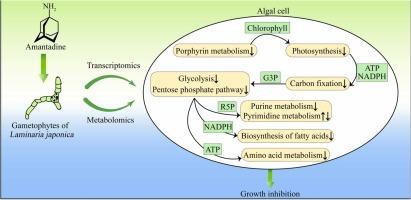Integrated metabolomics and transcriptomics analyses for understanding the mechanism underlying amantadine-induced toxicity in Laminaria japonica
IF 12.2
1区 环境科学与生态学
Q1 ENGINEERING, ENVIRONMENTAL
引用次数: 0
Abstract
The antiviral agent, amantadine, is widely present in marine ecosystems and poses a significant threat to marine organisms. However, studies on the toxicity of amantadine across the full life cycle of the brown alga Laminaria japonica, particularly during the microscopic gametophyte stage, remain lacking. A comprehensive approach combing biochemical analyses and multi-omics techniques was employed to investigate the mechanisms underlying amantadine-induced toxicity in L. japonica gametophytes. The development rate of algal cells was less than 3 % from 103 to 107 ng/L of amantadine. In total, 1049 differentially expressed genes and 215–231 differential metabolites were detected, with the majority involved in amino acid, lipid, and carbohydrate metabolism. Integrated analysis showed that alginate biosynthesis and glycerophospholipid metabolism were affected, suggesting damage to the cell wall and membrane structure. Key genes (e.g., SOD2) and metabolites (e.g., arachidonic acid and α-linolenic acid), associated with the antioxidant system and arachidonic acid metabolism, were identified, leading to oxidative stress in the algae. Furthermore, the downregulation of genes and metabolites involved in porphyrin metabolism, photosynthesis, carbon fixation, glycolysis, and the pentose phosphate pathway may inhibit ATP supply and NADPH generation, negatively affecting metabolic processes and inhibiting algal cell growth. In contrast to disrupting protein synthesis in juvenile sporophytes, amantadine primarily interferes with photosynthesis and carbohydrate metabolism in gametophytes. These findings offer new insights into the mechanisms by which amantadine impedes the growth and metabolism of algae throughout their life cycle in aquatic ecosystems.

求助全文
约1分钟内获得全文
求助全文
来源期刊

Journal of Hazardous Materials
工程技术-工程:环境
CiteScore
25.40
自引率
5.90%
发文量
3059
审稿时长
58 days
期刊介绍:
The Journal of Hazardous Materials serves as a global platform for promoting cutting-edge research in the field of Environmental Science and Engineering. Our publication features a wide range of articles, including full-length research papers, review articles, and perspectives, with the aim of enhancing our understanding of the dangers and risks associated with various materials concerning public health and the environment. It is important to note that the term "environmental contaminants" refers specifically to substances that pose hazardous effects through contamination, while excluding those that do not have such impacts on the environment or human health. Moreover, we emphasize the distinction between wastes and hazardous materials in order to provide further clarity on the scope of the journal. We have a keen interest in exploring specific compounds and microbial agents that have adverse effects on the environment.
 求助内容:
求助内容: 应助结果提醒方式:
应助结果提醒方式:


